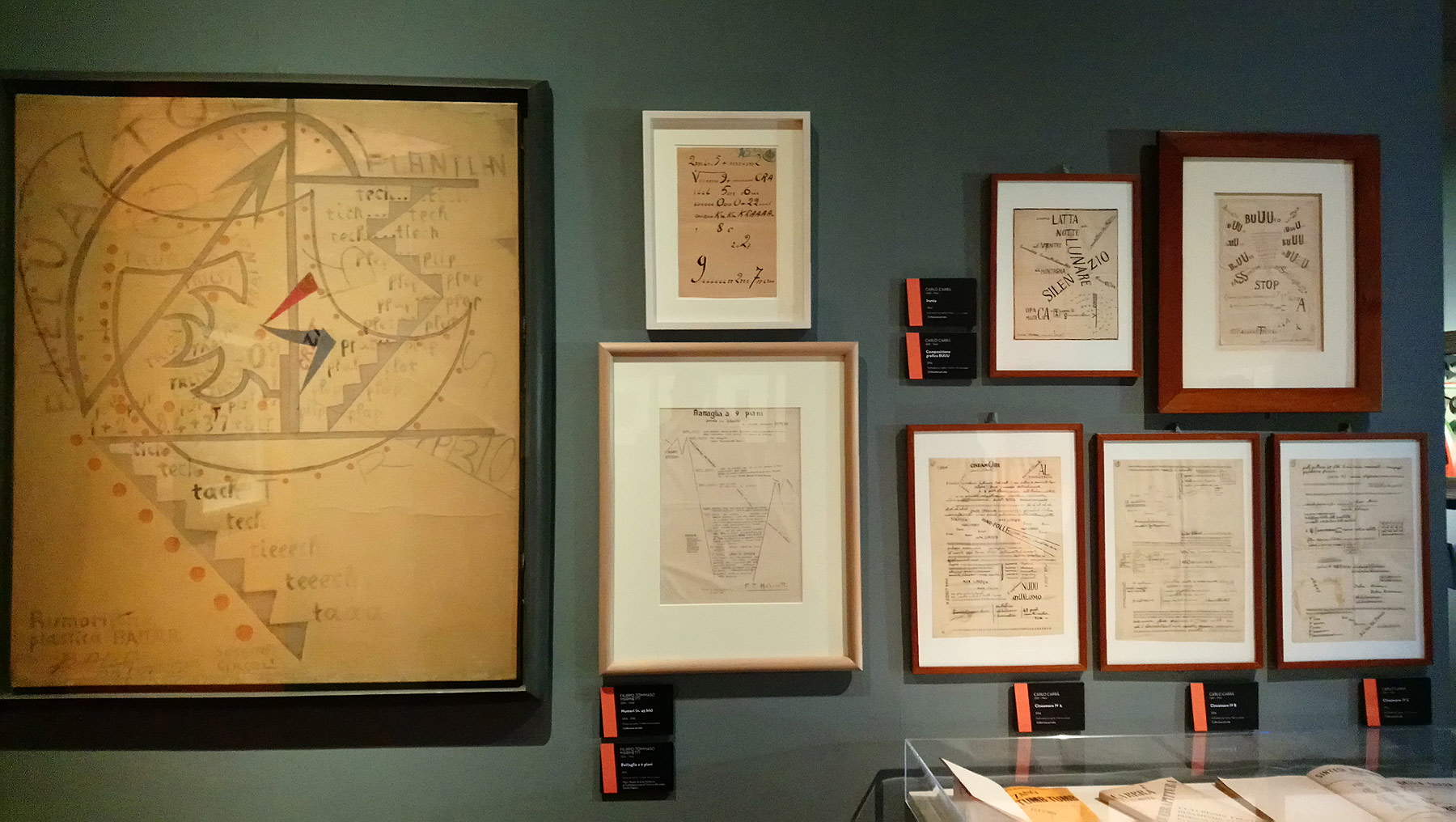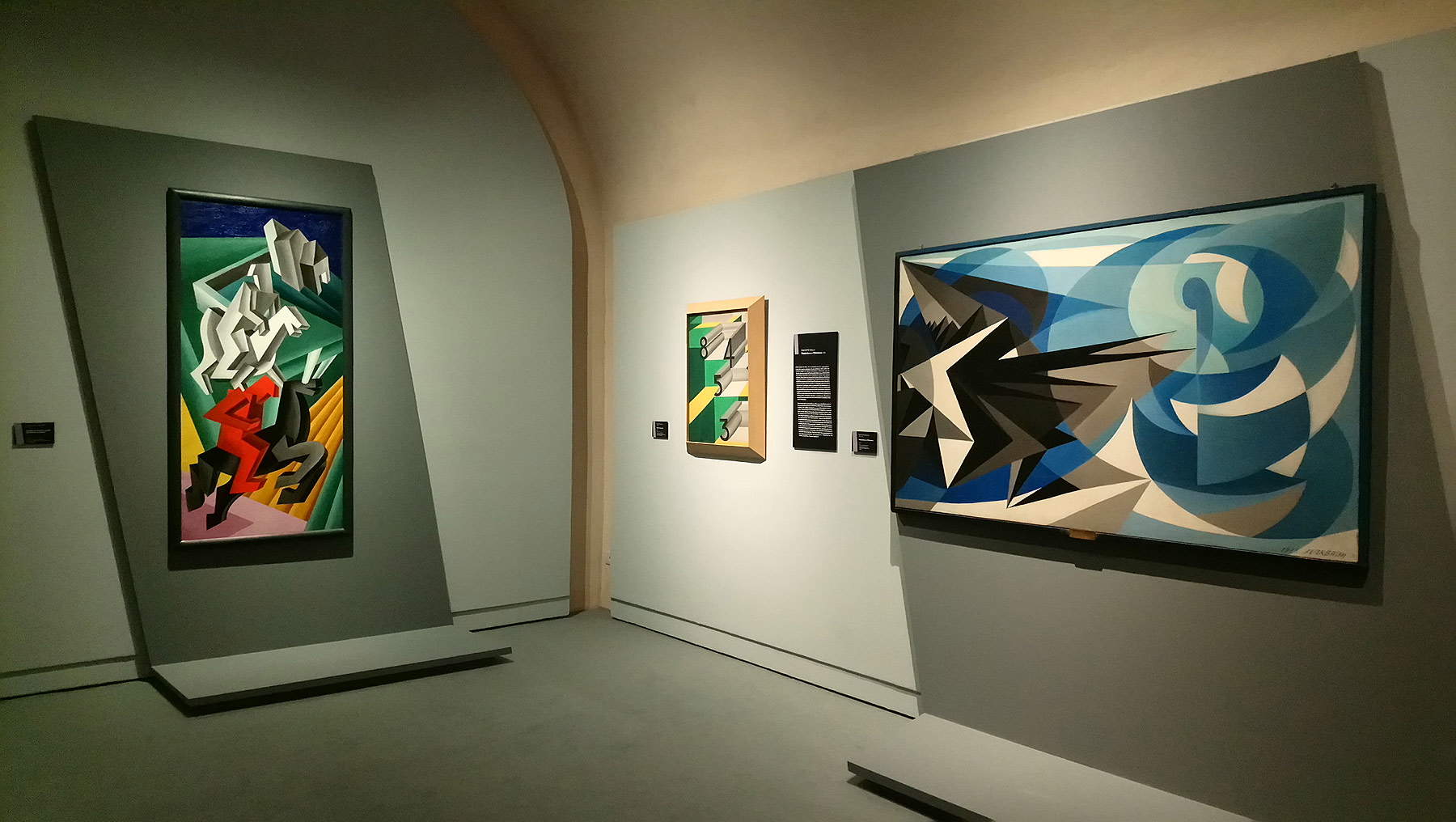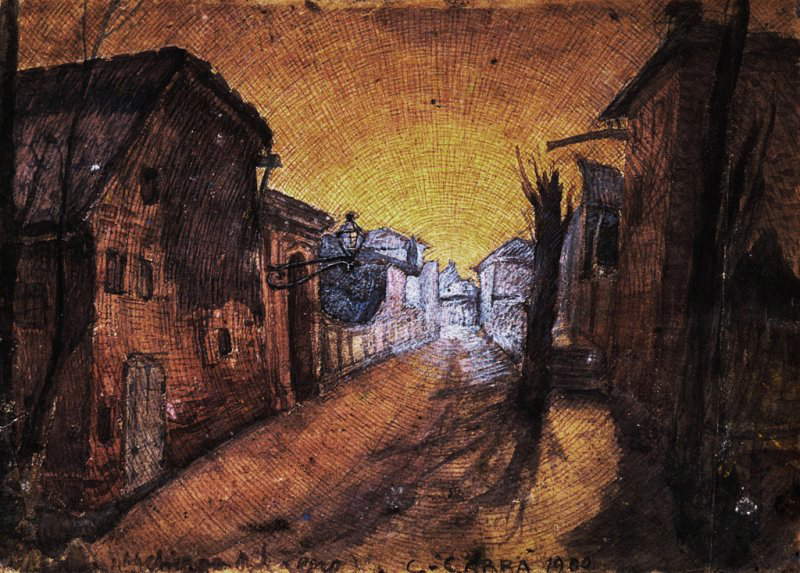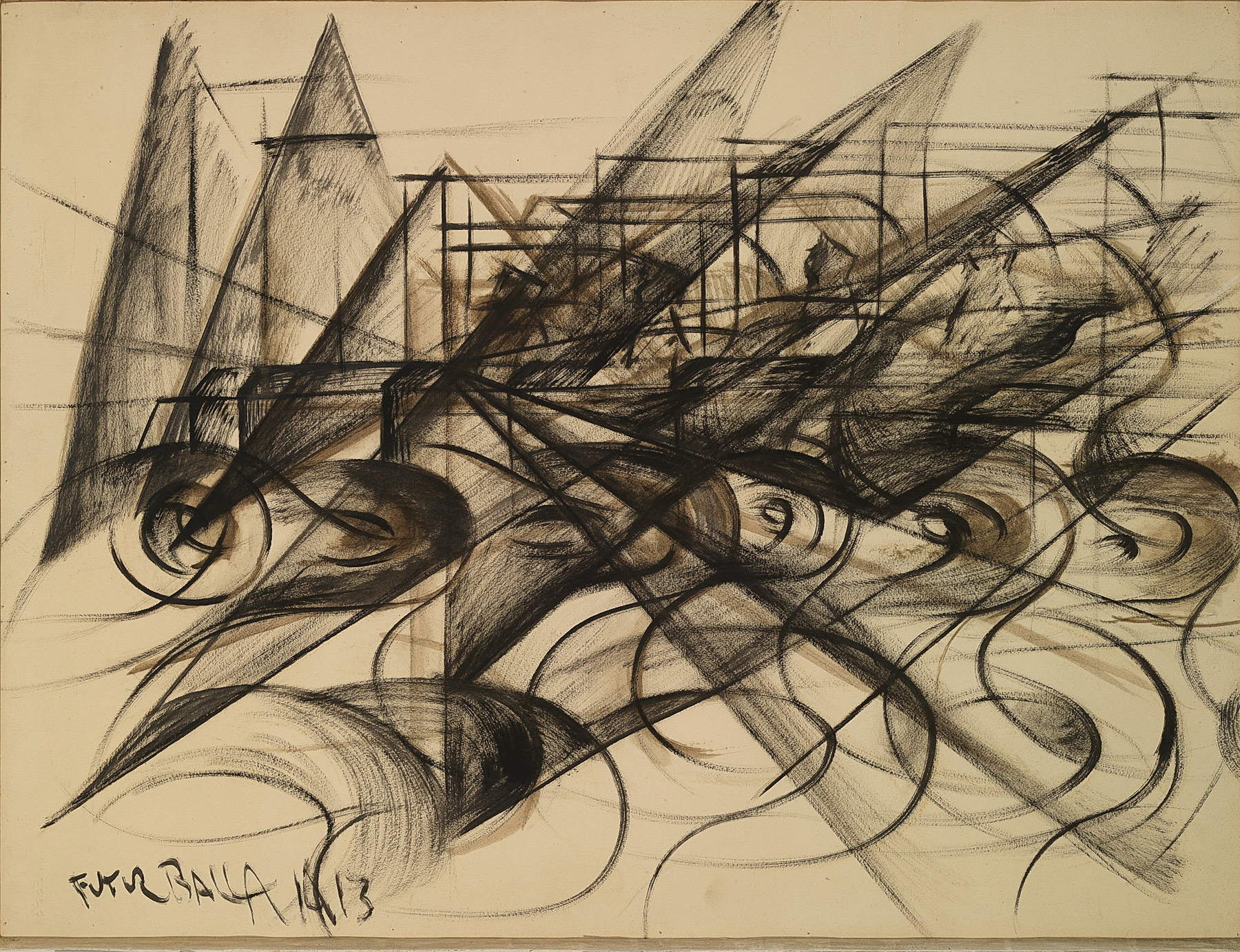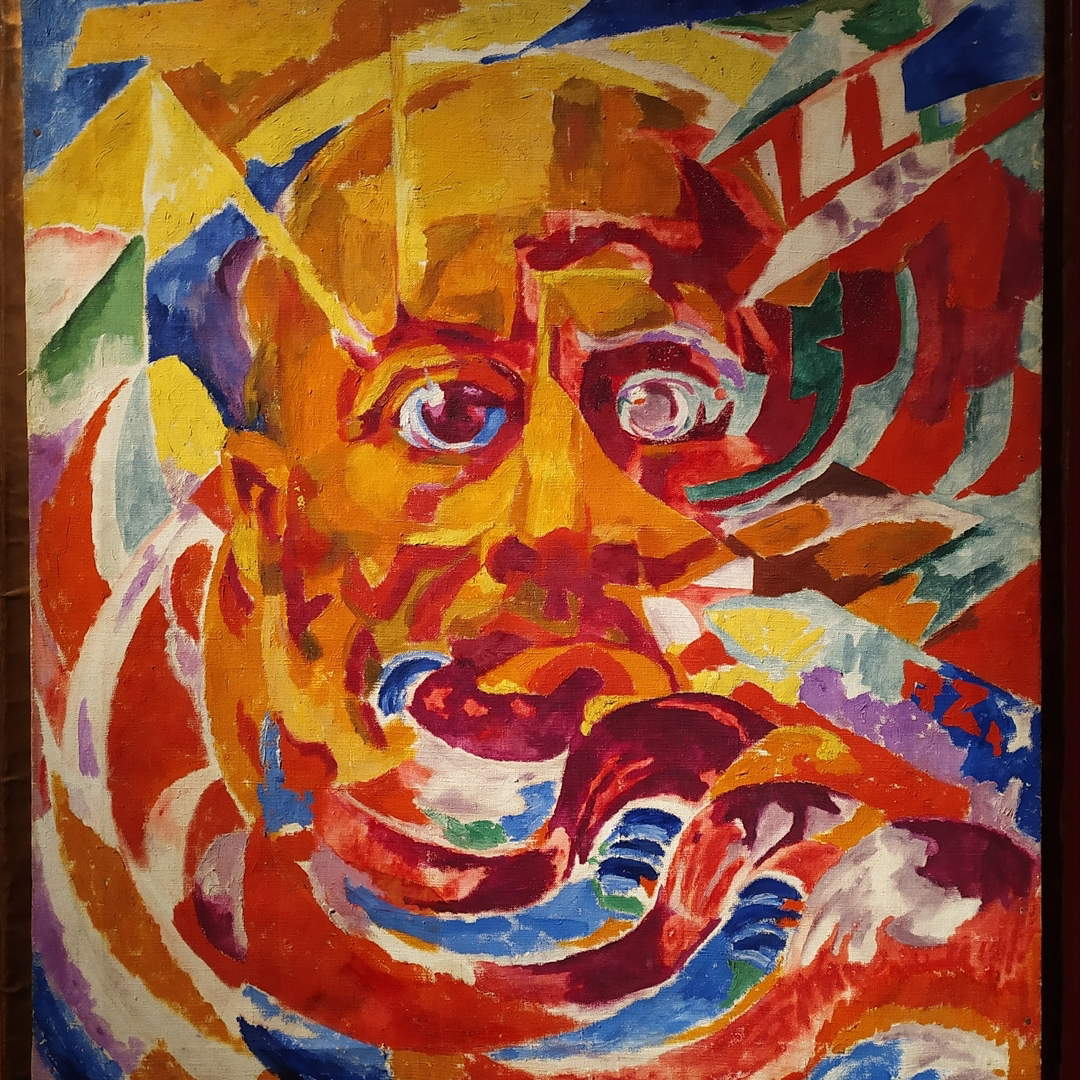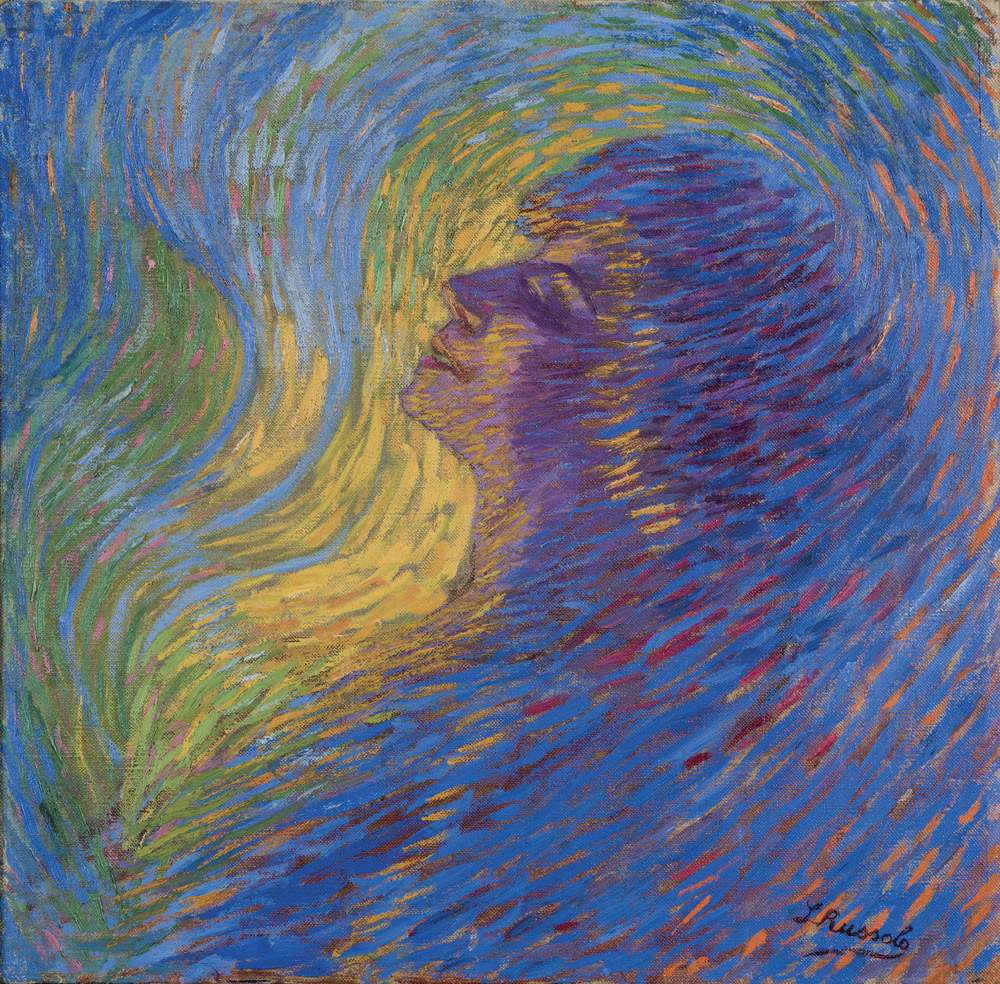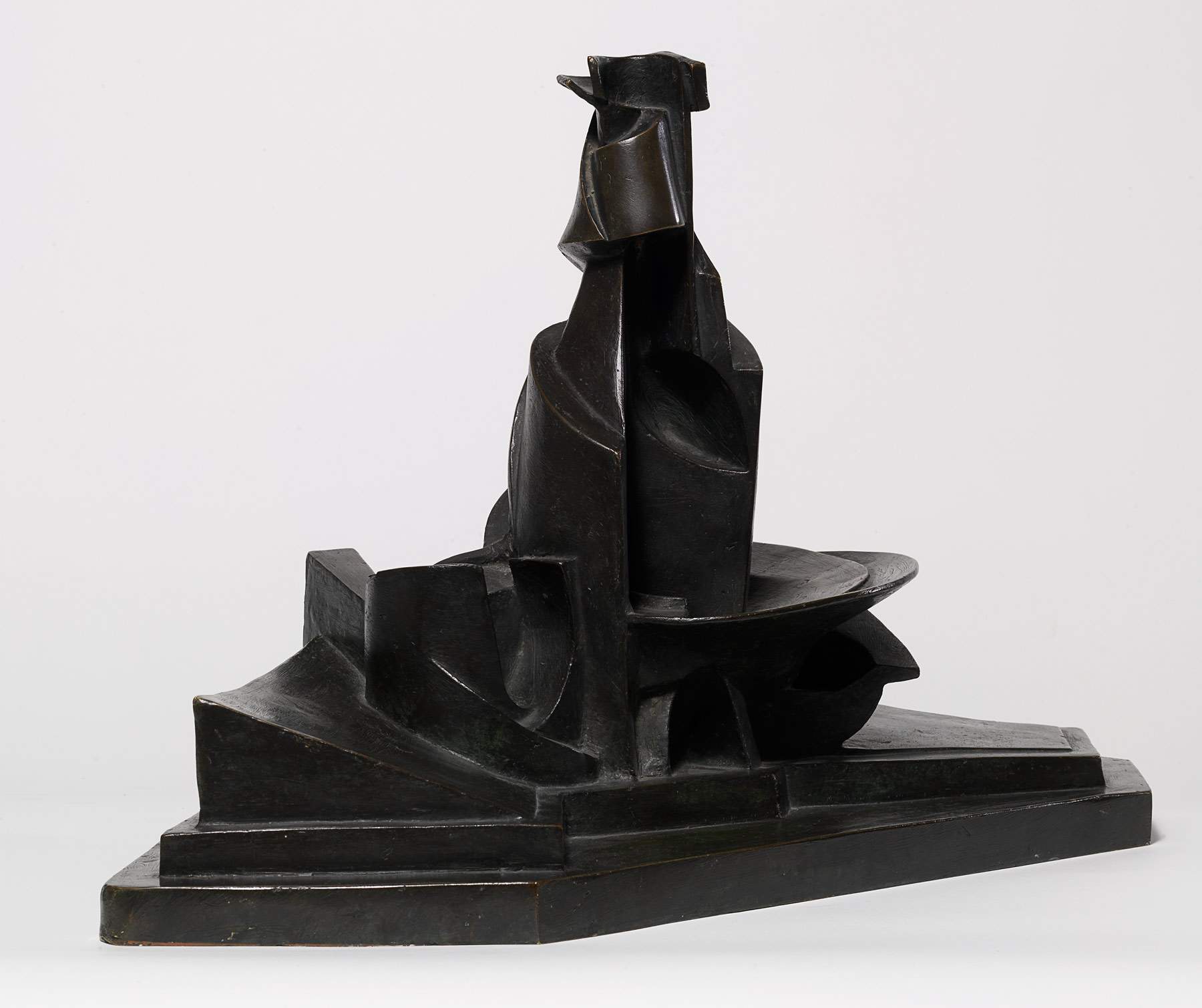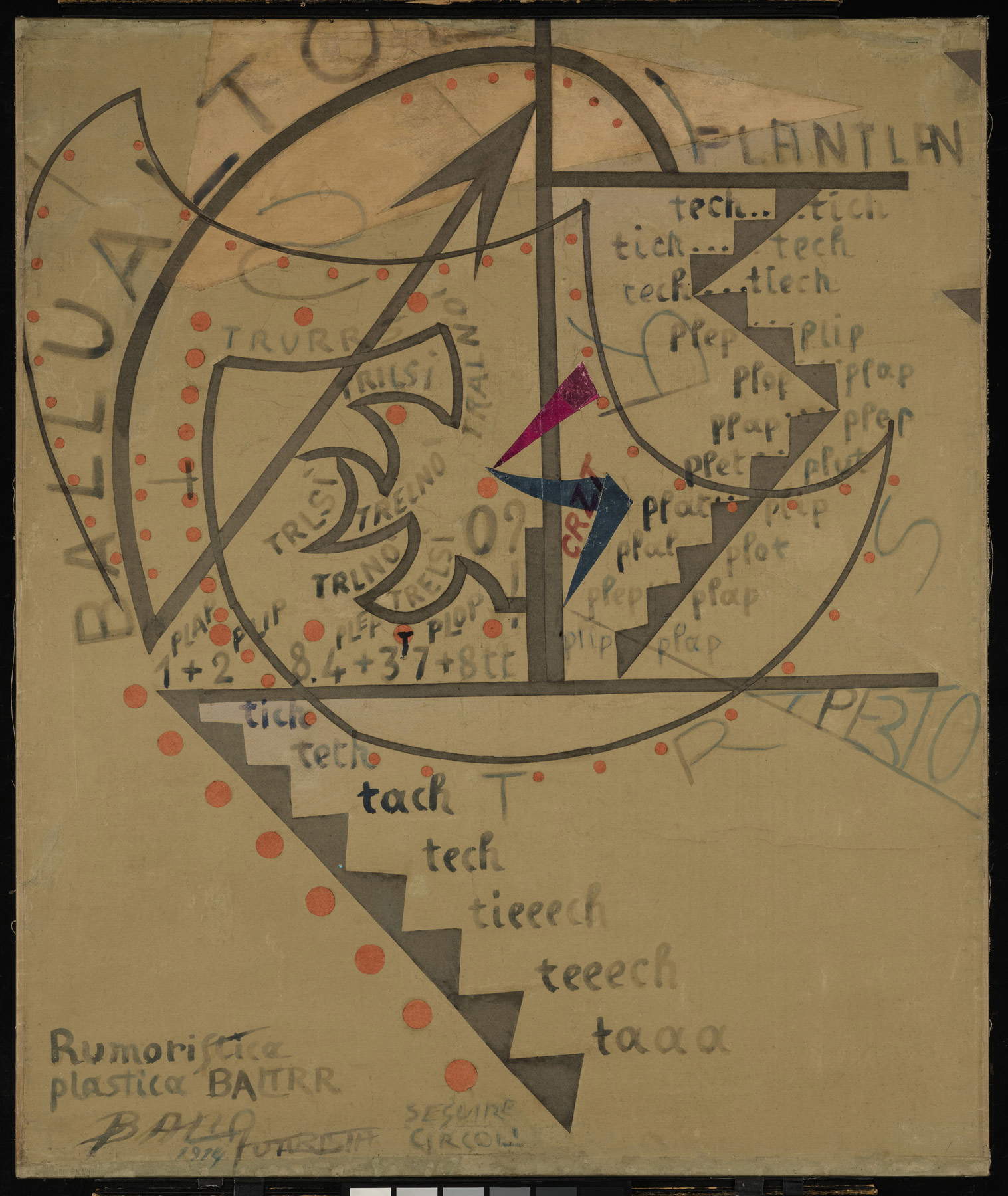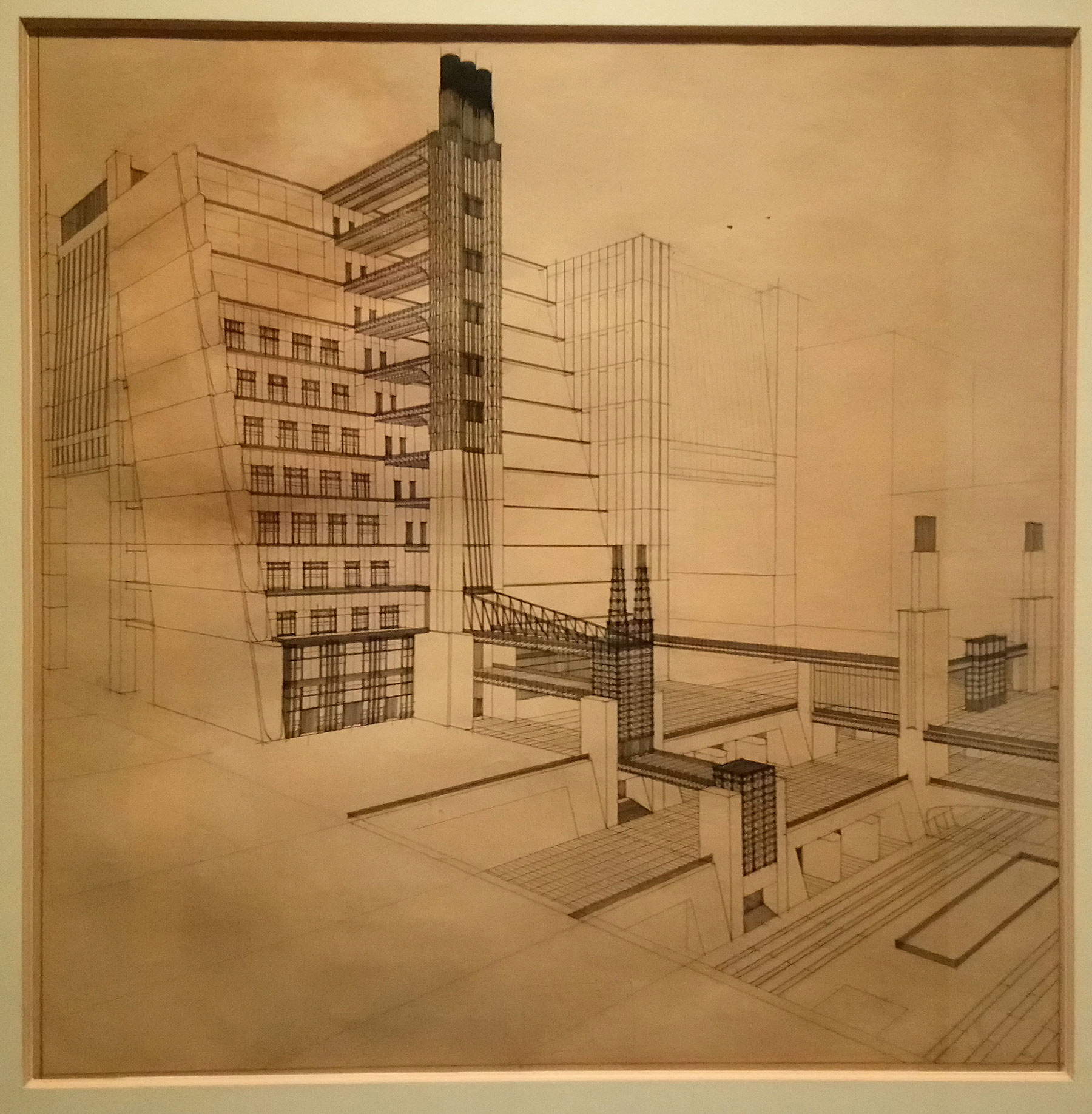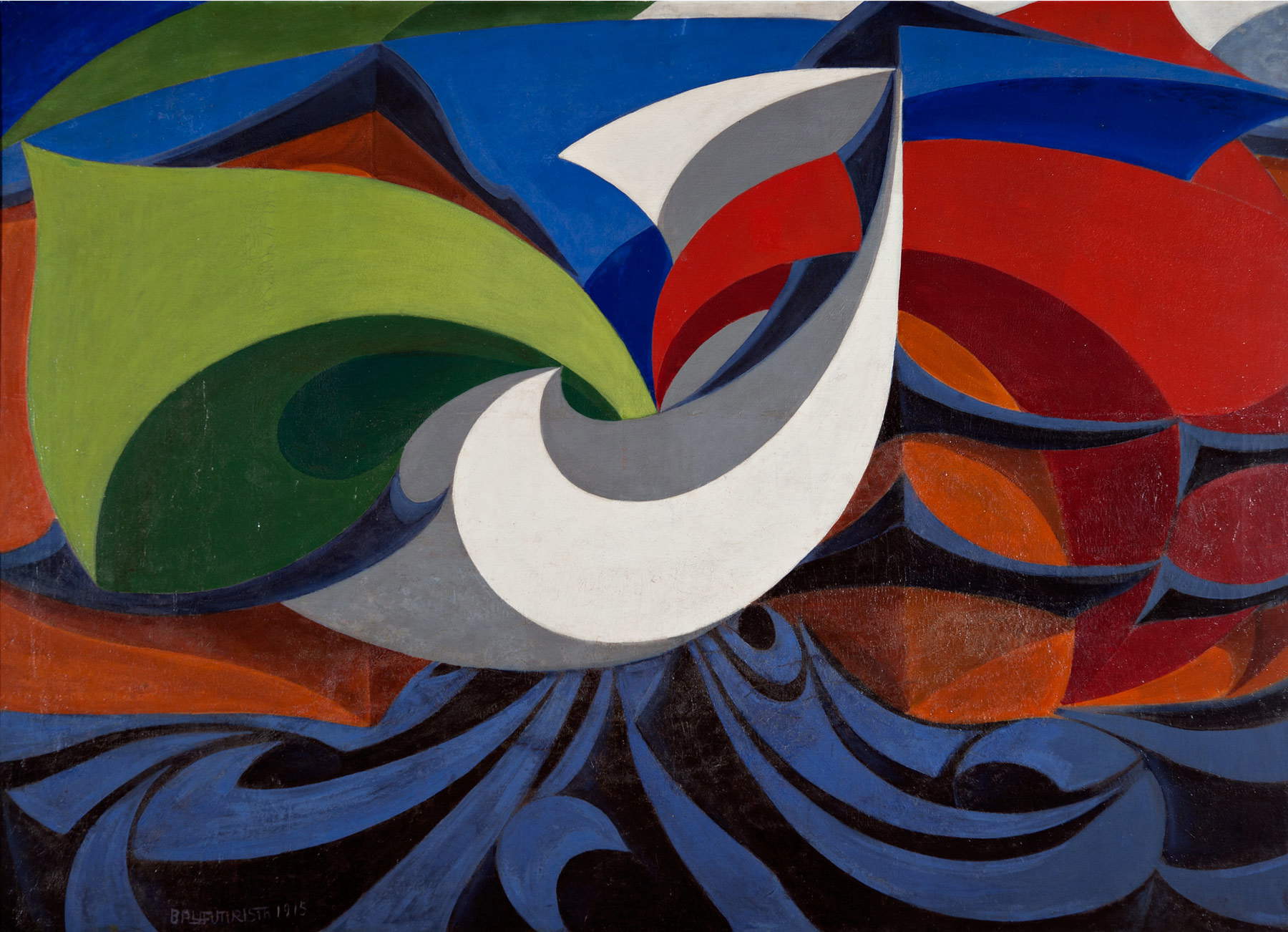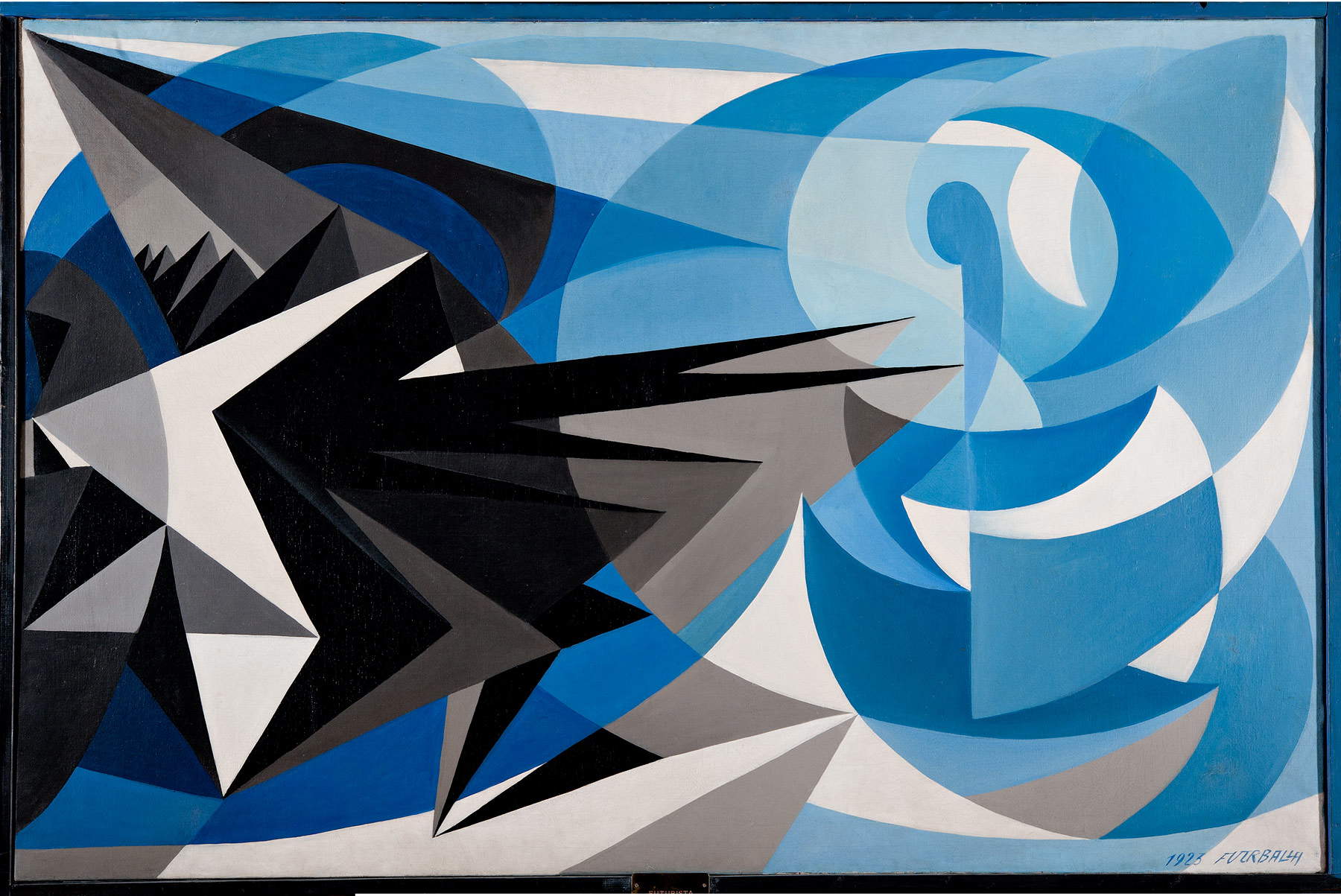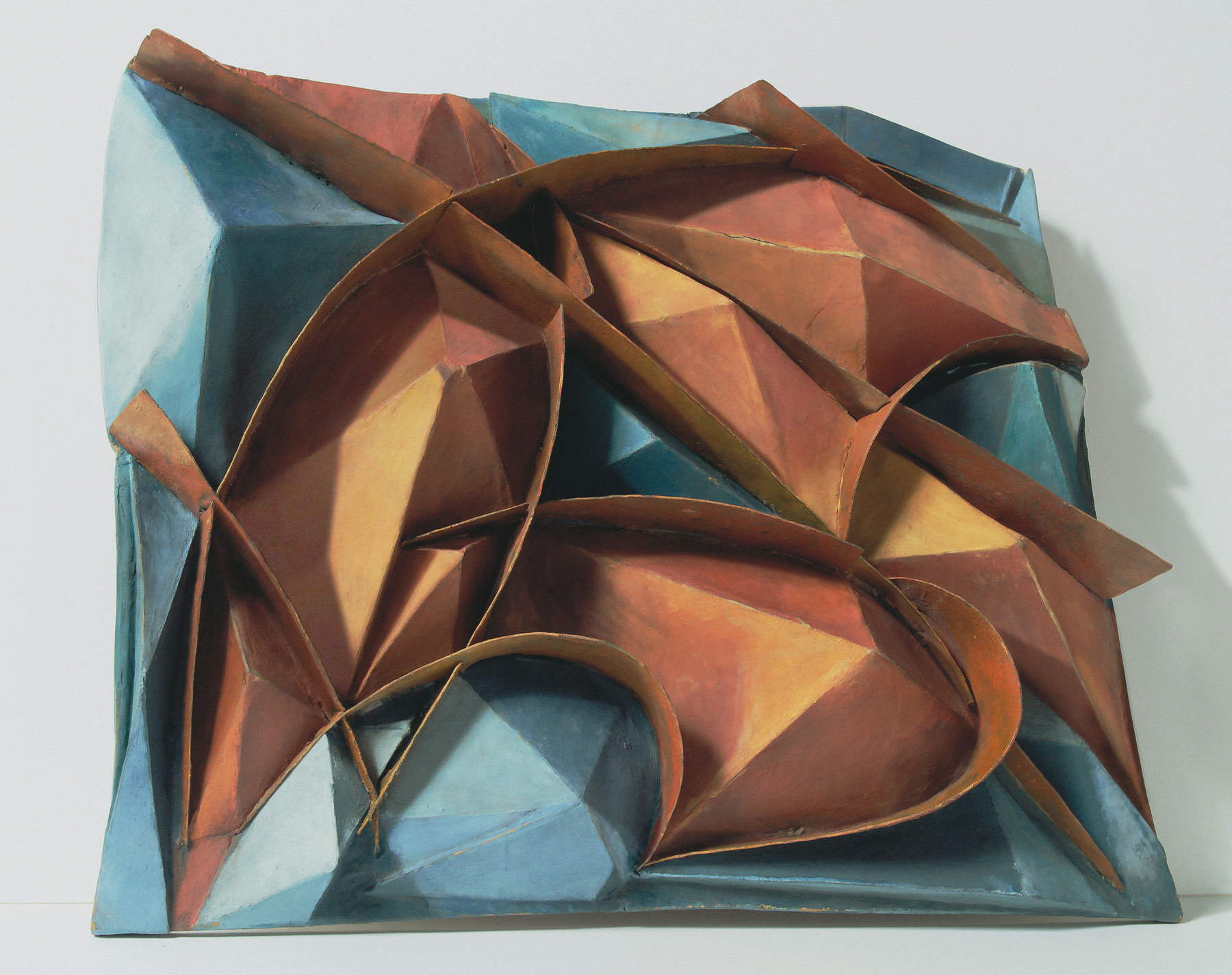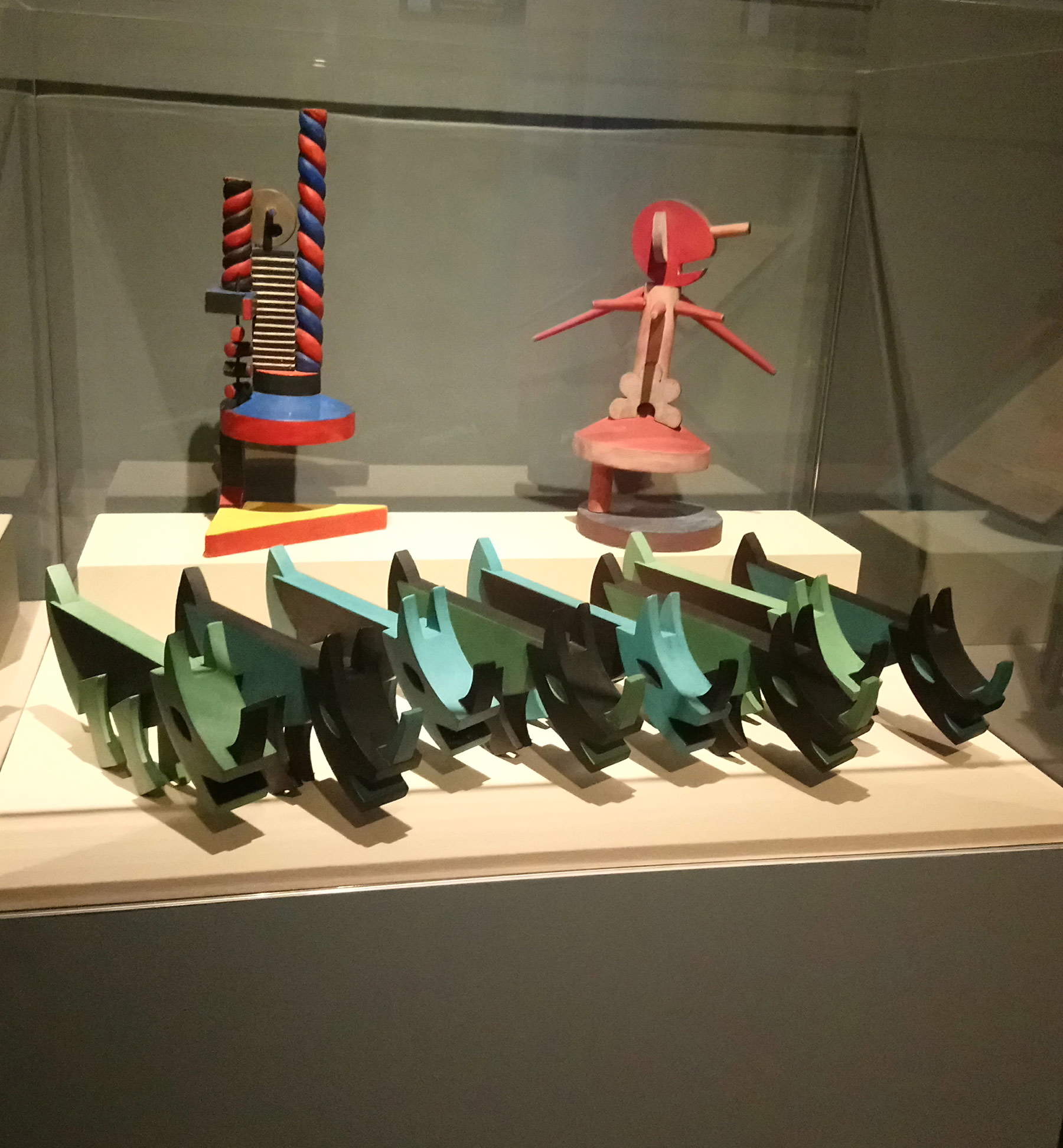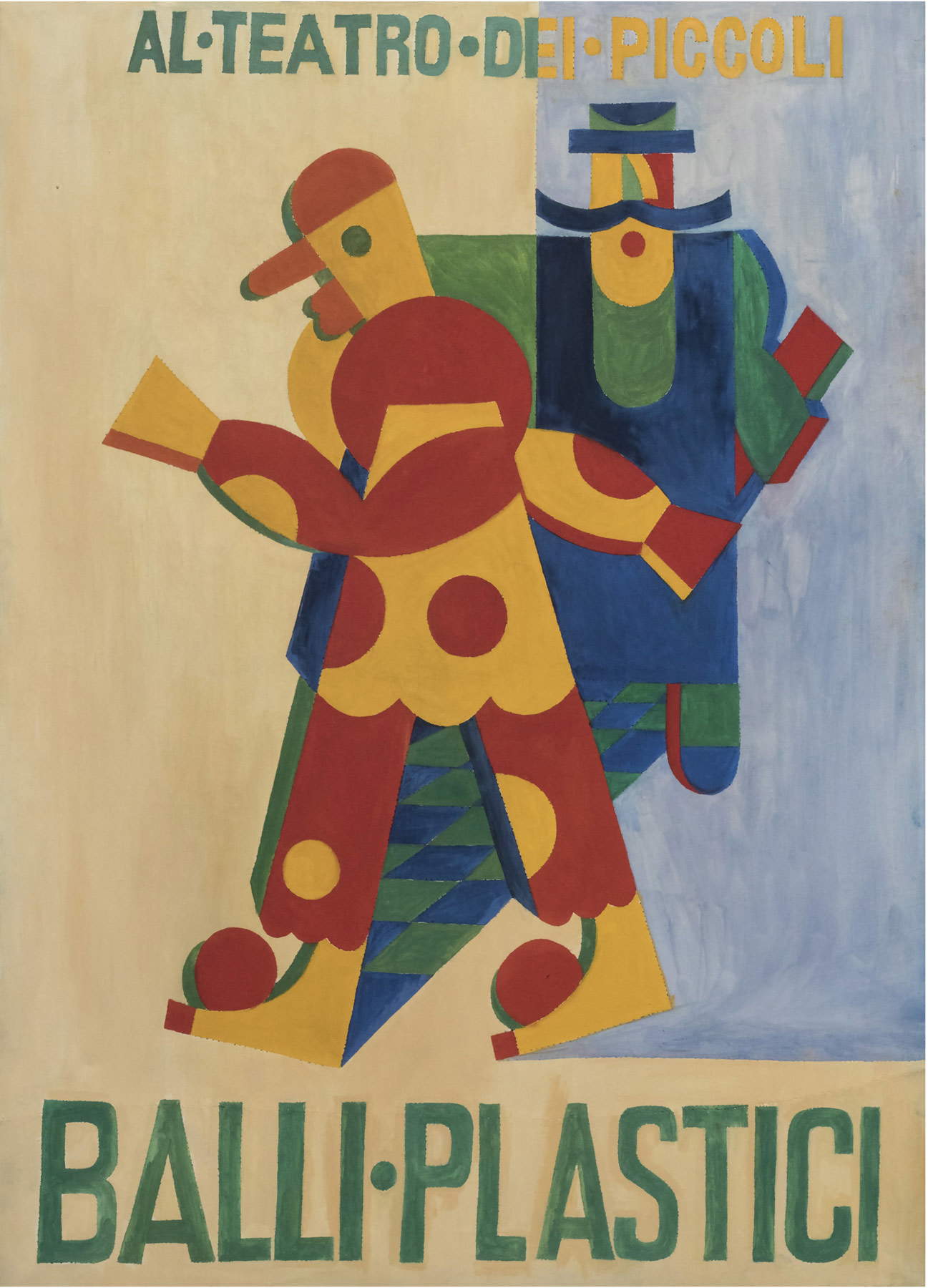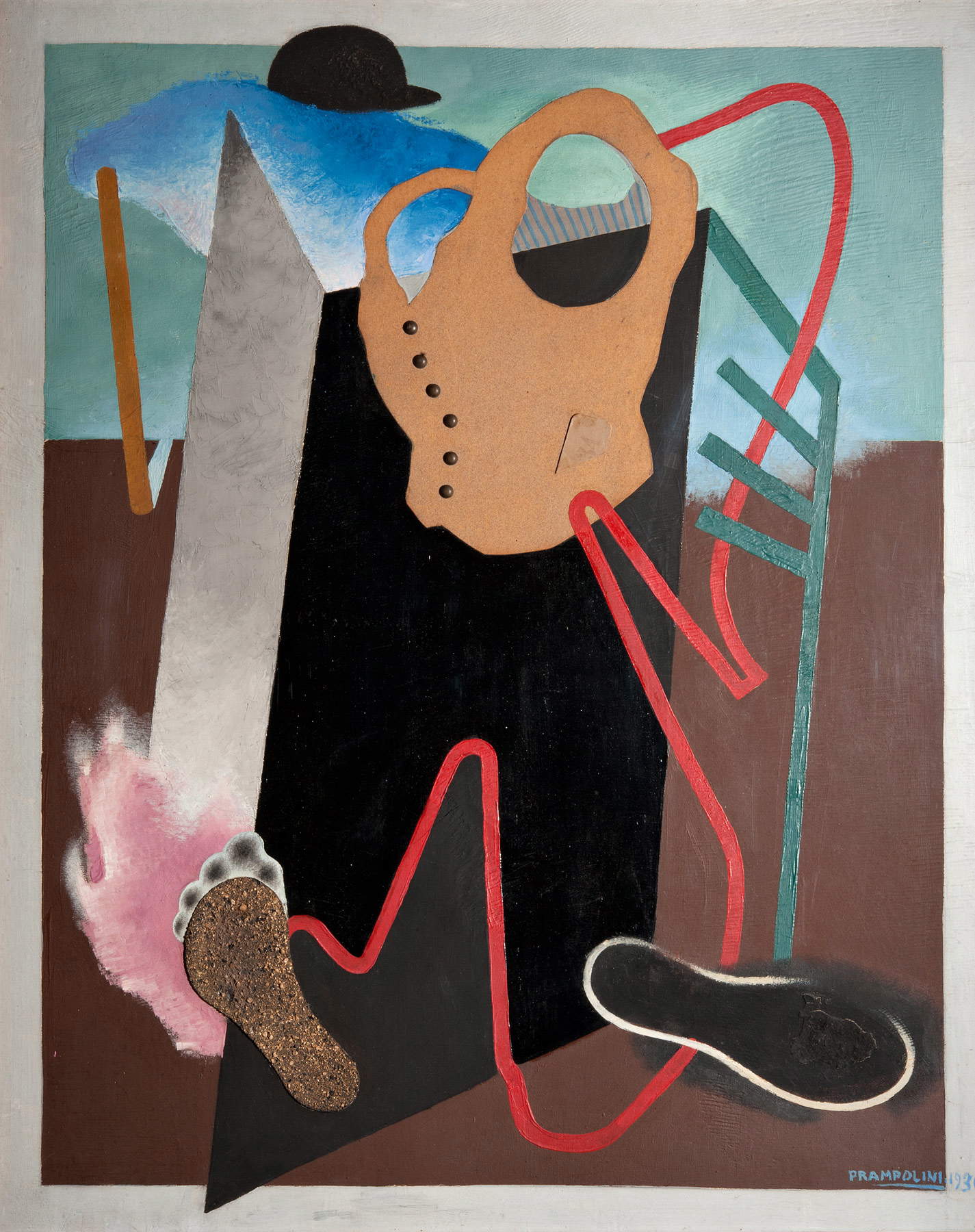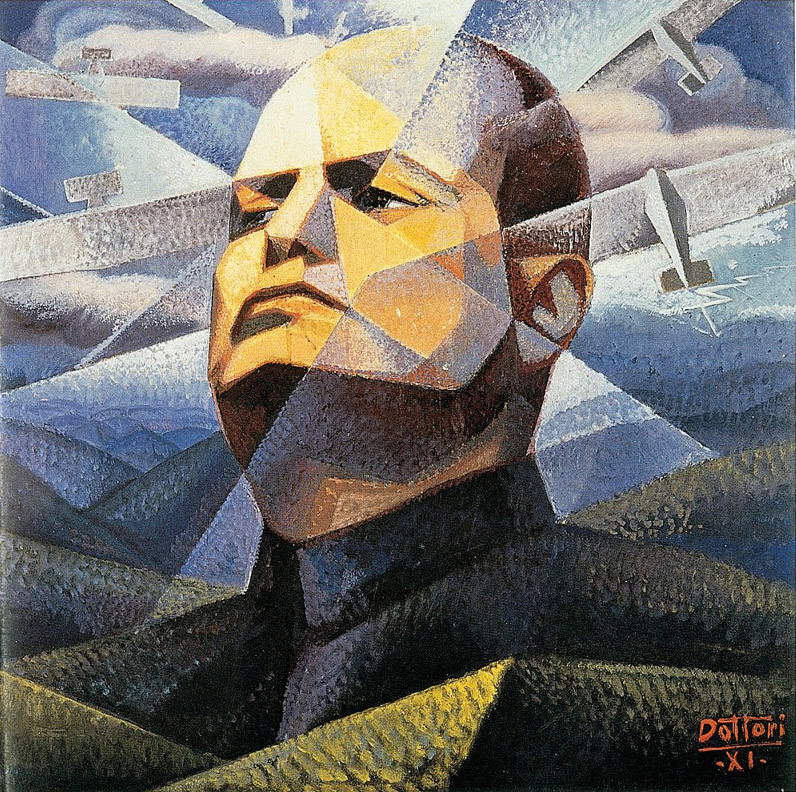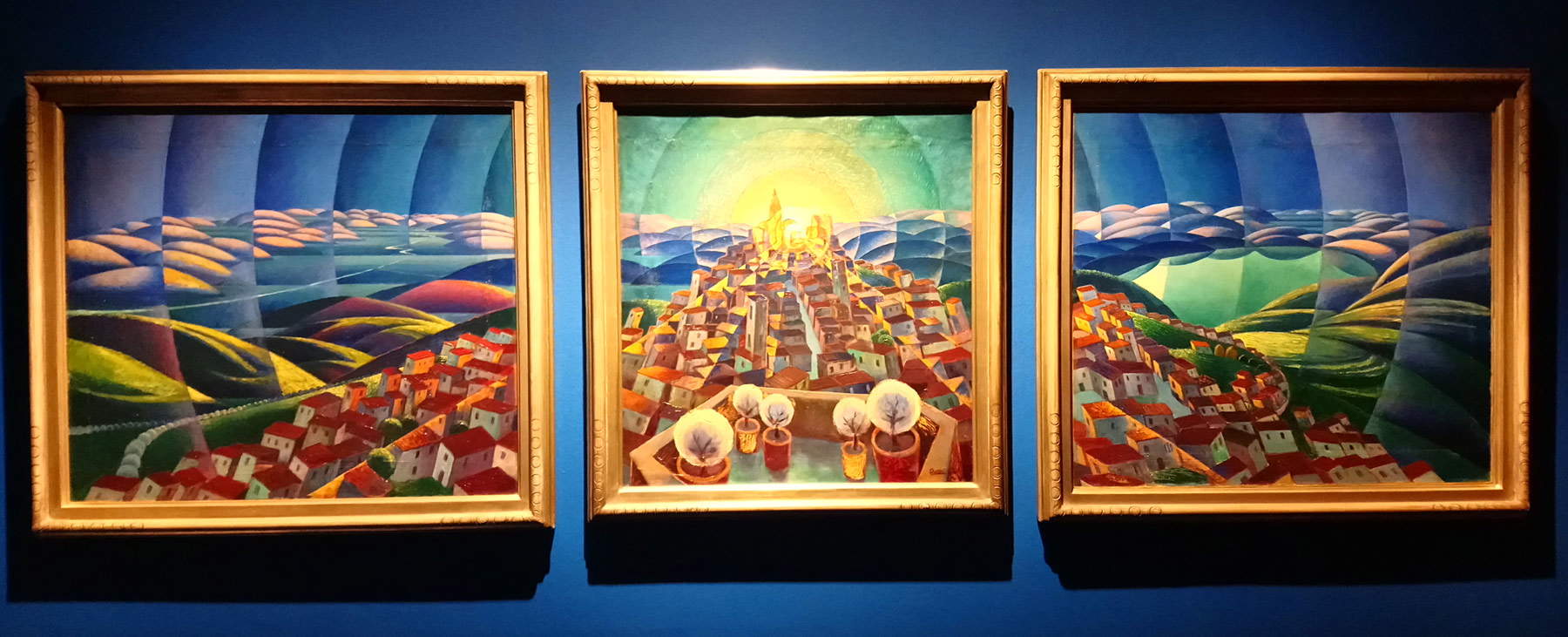by Federico Giannini (Instagram: @federicogiannini1), published on 19/12/2019
Categories: Exhibition reviews
/ Disclaimer
Review of the exhibition "Futurism," in Pisa, Palazzo Blu, October 11, 2019 to February 9, 2020.
If today we admire fundamental masterpieces of the Futurists in museums halfway around the world, we owe that possibility to the substantial disinterest (if not toostracism tout court) that the cultural milieu of postwar Italy reserved for Boccioni and colleagues. Many works by the great artists who animated the unique Italian avant-garde of the early twentieth century were exported without the slightest resistance from the institutes in charge of protection, and the result is today before everyone’s eyes: paintings, sculptures, drawings, works on which the movement was founded, can now be found on every continent. It may be thought, however, that perhaps it was just as well: if today the importance of futurism is universally recognized across the globe, thanks must also be given to those who thought of striking it down or disposing of it by simply ignoring it. Certain patterns, however, in part still survive today, if one thinks that, on the occasion of the major Futurism exhibition held in 2014 at the Guggenheim in New York, there were those who wrote that Futurist aeropainting had made a key contribution to the visual imagery of the Fascist regime, despite the fact that Enrico Crispolti warned critics against incorrect attempts to liquidate it, especially the so-called “second Futurism,” as early as forty years ago. And, following an approach typical of American critics, the U.S. review did not spare a few more barbs against the alleged misogyny of Filippo Tommaso Marinetti (Alexandria, Egypt, 1876 - Bellagio, 1944). However, the New York exhibition had the merit of having ordered, for the first time, a selection capable of looking at futurism as a movement that developed along more than thirty years of the history of the twentieth century without interruption.
The same time horizon, which goes from 1909, the date of Marinetti’s publication of the Manifesto of Futurism (first in the Gazzetta dell’Emilia on February 5 of that year, then in other Italian publications, and later, on February 20, in Le Figaro: from the French newspaper he would obtain the international resonance that he had previously lacked), to 1944, the year of his great theorist’s death, is the same one adopted by the exhibition Futurismo, curated by Ada Masoero, set up in the rooms of Palazzo Blu in Pisa until February 9, 2020. The Tuscan exhibition thus fits into the groove of the most recent exhibition events, aimed at considering Futurism in its entirety and not only in the span of its first ten years, those on which studies have focused most. The uniqueness of the exhibition lies in the way the curator decided to construct theiter: by matching the different sections of the exhibition with the various manifestos drawn up by the exponents of the movement. The result is an itinerary that, by Ada Masoero’s own admission, intends to let the artists have their say: and as a result, only works by artists who signed the manifestos are on display in the exhibition, albeit with two shining exceptions: one is the portrait of Marinetti painted by Rougena Zátková (Prague, 1885 - Leysin, 1923), and the other is the significant Prima che si apra il paracadute by Tullio Crali (Igalo, 1910 - Milan, 2000), the longest-serving exponent of the movement (albeit one who joined it without signing the manifestos), present in the exhibition since Marinetti considered him “the greatest painter of the moment” (“the first and so far unique among aeropainters,” the poet is said to have said in 1940 during a radio interview, “Crali appears the acrobat who paints his own moods and landscapes upside down, oblique, spinning, which he enjoyed and lightning-quickly abducted with gyrating sensitivity in his aviation experience”).
 |
| A room of the Futurism exhibition in Pisa |
 |
| A room of the Futurism exhibition in Pisa |
 |
| A room of the Futurism exhibition in Pisa |
 |
| A room from the Futurism exhibition in Pisa |
 |
| Tullio Crali, Before the Parachute Opens (1939; oil on panel, 141 x 151 cm; Udine, Museum of Modern and Contemporary Art) |
By way of introduction, the Pisa exhibition arranges a first sequence of works intended to give an account of the debuts of some of the early Futurists under the sign of divisionism: debuts that point out, on the one hand, how the various Umberto Boccioni (Reggio Calabria, 1882 - Verona, 1916), Carlo Carrà (Quargnento, 1881 - Milan, 1966), Luigi Russolo (Portogruaro, 1885 - Laveno-Mombello, 1947), Giacomo Balla (Turin, 1871 - Rome, 1958) and Gino Severini (Cortona, 1883 - Paris, 1966) were up-to-date and in step with the latest developments in Italian painting, and on the other hand what was the culture in which the young people who would sign the manifestos of Futurism were formed. The fact that the exhibition emphasizes the debt of the Futurists to Divisionism is also expedient to show how the research of Pellizza and associates (it will be useful to note that Balla, the oldest of the Futurists, thirty-eight at the time of the publication of Marinetti’s manifesto while the others were all daring twenty-five-year-olds or so, had known the great painter from Volpedo, and had been referred to by Severini as “our master who initiated us into the new technique of pointillism, without, however, teaching us its fundamental and scientific rules”) had held vital importance for future Futurist experiments on light and movement. And it is from this perspective that one must read, for example, an extraordinary work by a Carrà who was little more than an adolescent, La strada di casa (The Street at Home ) of 1900, which, despite its youthful uncertainty, conveys all the spirit of a Segantini (whom Carrà had approached as a boy admiring his works in Milan), or The Mother, a pastel by Boccioni on loan from the collections of the Galleria d’Arte Moderna in Milan, where we can admire the whole path of the light that penetrates through the window panes (it lingers on the face of the woman intent on crocheting, descends down the lace of the shawl, making the figure lose its contours and imparting a delicate dynamism by means of an almost punctiform painting, and ends by illuminating the floor), to arrive at the domestic tenderness of Balla, still on the verge of the Futurist turn, who in Affetti (exhibited here in a preliminary study) sketches an intense portrait of his wife Elisa and daughter Luce.
The moment of the founding of Futurism arrives between the second and third rooms: in almost every room of the exhibition, reproductions of the posters that punctuate the exhibition itinerary are arranged, so as to follow the narrative of the exhibition guided by the very voice of the protagonists of that new cultural temperament. “We affirm that the magnificence of the world has been enriched with a new beauty; the beauty of speed,” wrote Marinetti in what is perhaps the most famous passage of his manifesto. “A racing automobile with its hood adorned with large snake-like tubes with explosive breath ... a roaring automobile, which seems to run on machine gun fire, is more beautiful than the Victory of Samothrace.” And here it is, the automobile (which for the Futurists was to be declined strictly in the masculine form), running in a watercolor by Balla, Automobile + speed + light, made just three years after the study for the Affects exhibited in the room before but already far removed from past experiences. And again, “we want to glorify war-the world’s only hygiene-militarism, patriotism, the destructive gesture of libertarians, the beautiful ideas for which people die, and the contempt of women.” And in correspondence with Marinetti’s words, the room features Boccioni’s Charge of the Lancers, a 1915 painting that in swirling motion extols the strength and speed of the horses and the courage and motivation of the lancers in a highly idealized vision of war, and the aforementioned portrait of Marinetti executed by Rougena Zátková, one of the best-known Futurist women, in every way equal to her male colleagues: the Futurists abhorred woman “divine reservoir of love, woman poison, woman tragic trinket, woman fragile, haunting and fatal” (so wrote, Marinetti, in polemic with the image of woman of the Romantics, Symbolists and Decadents, in his 1910 manifesto Against Love and Parliamentarism: for him, to be equally despised were the bourgeois woman, condemned to a subordinate and insignificant life, and the femme fatale who ensnares the man), and on the contrary exalted the strong, independent woman, conscious of her talents and intelligence, capable of action, equal to the male, and for whom Marinetti hoped for the right to vote and full participation in the political life of the country.
The founders of Futurism (Boccioni, Carrà, Russolo, Balla Severini) would later sign, on February 11, 1910, the Manifesto of the Futurist Painters, followed on April 11 of the same year by the Technical Manifesto: and here, too, the review does not deviate from the intention of continuing to enshrine the union between the movement’s theoretical texts and the works of their signatoriesî. Severing ties with the academy, destroying “the cult of the past, the obsession with the ancient, pedantism,” exalting originality even when violent, “considering art critics as useless and harmful,” and “rendering and magnifying life today”-these were the lines of the five young “fathers” of futurism, for whom, as they themselves would write in the Technical Manifesto, “everything moves, everything runs, everything turns quickly.” In the room dedicated to the beginnings of Futurist painting, one thus encounters works such as Balla’s Ritmo + velocità (Rhythm + Speed ), where the protagonist is once again the automobile, which the painter observes in its rapid advance that cleaves the air and raises the dust of a quiet countryside, or Severini’s L’autobus (The Bus ), where the movement of the celebrated urban life (in this case of the Paris of the 1910s) is also given, according to the typical Futurist procedure, by the swirling interpenetration between space and objects. And a painting with still pointillist accents such as Russolo’s celebrated Perfume of 1910 is perhaps the painting that more than any other gives evidence to the theoretical assumption that “beneath our epidermis does not snake brown, but [....] yellow shines there, [...] red flames there, and [...] green, blue and violet dance there, voluptuous and caressing,” and “the human face is yellow, it is red, and green, it is blue, it is violet.” In the dreamy face of Russolo’s woman floats, breaks and dances a wave of darting brushstrokes that give shape to the idea that “the pallor of a woman gazing into a jeweler’s window is more iridescent than all the prisms of the jewels that fascinate her.”
 |
| Carlo Carrà, The Road Home (1900; ink and watercolor on cardboard, 25.5 x 35.5 cm; Private collection) |
 |
| Umberto Boccioni, The Mother (1907; pastel on paper applied to canvas, 72 x 80 cm; Milan, Galleria d’Arte Moderna, Grassi Collection) |
 |
| Giacomo Balla, Study for Affects (1910; oil on panel, 68 x 52 cm; Rome, Private Collection - courtesy Futur-ism) |
 |
| Giacomo Balla, Automobile + Speed + Light (1913-1914; watercolor and sepia on paper, 67 x 88.5 cm; Milan, Museo del Novecento) |
 |
| Umberto Boccioni, Charge of the Lancers (1915; pen and black ink, tempera and collage on paper applied to canvas, 33.4 x 50.3 cm; Milan, Museo del Novecento) |
 |
| Rougena Zátková, Marinetti soleil (1921-1922; oil on canvas, 100 x 89 cm; Private collection) |
 |
| Gino Severini, The Bus (1913; oil on canvas, 57 x 73 cm; Milan, Museo del Novecento) |
 |
| Luigi Russolo, Perfume (1910; oil on canvas, 65.5 X 67.5 cm; Rovereto, Mart, Museo di arte moderna e contemporanea di Trento e Rovereto, VAF-Stiftung Collection) |
The scarcity of sculptures in the section devoted to the Technical Manifesto of Futurist Sculpture, signed by Boccioni on April 11, 1912, is compensated for by the opportunity to admire the only three-dimensional work on display in the room (a masterpiece by the artist of Reggio Emilia origins: the Development of a Bottle in Space, arriving from the Museo del Novecento in Milan) alongside a number of drawings that testify to the genesis of Boccioni’s ideas (starting with his most famous sculpture, Unique Forms of Continuity in Space). For Boccioni, sculpting essentially meant translating, through matter, the “atmospheric planes that bind and intersect things,” bringing objects to life by communicating to the relative the idea of their arrangement in space (since an object ends where another object begins, and since an object is surrounded by other objects) and their movement, to be rendered in synthesis to continue whatImpressionism (Boccioni was referring to Medardo Rosso’s sculptures) had begun analytically. Development of a Bottle in Space, from 1912, is also Boccioni’s first sculpture and is, for that reason, steeped in the theoretical foundations formulated by the author shortly before the work was created: still life, a typical theme of the Cubist tradition (and in regard to Cubism, Roberto Longhi pointed out, Futurism was like the Baroque in regard to the Renaissance), takes on in Boccioni’s sculpture an unprecedented movement that also grants it an architectural dimension that almost makes it monumental, despite its small size and despite the ordinariness of the subject chosen by the author. This is followed, as mentioned, by the drawings, which although not traceable to works that later actually took shape (they should therefore not be considered preparatory sketches), are illustrative of the way in which the artist looked at the human body in motion, and also of the way in which he intended the medium of drawing( I want tosynthesize the unique forms of continuity in space or I want to fix human forms in motion).
The following sections explore the different areas in which the Futurists were active: literature (and poetry in particular), architecture, and advertising, with an interlude (due to chronological reasons) on war. Marinetti returns in the section centered on the Technical Manifesto of Futurist Literature (and subsequent developments): words in freedom, as is well known, were the main contribution that Futurism introduced into the literary field. For Marinetti and the other Futurist poets, it was necessary to “destroy syntax by arranging nouns at random,” use the verb in the infinitive, abolish the adjective (“so that the bare noun retains its essential color,” plus the adjective , by giving a “nuance” to the noun, imposes a pause contrary to the Futurists’ principles of dynamism), abolish the adverb, abolish punctuation and introduce mathematical signs to indicate accents and directions, form networks of images: in the exhibition, compositions by Carrà, Balla and Marinetti himself make up a small constellation of creations somewhere between poetry and art. The following section finds space for a conspicuous collection of drawings by Antonio Sant’Elia (Como, 1888 - Monfalcone, 1916), arriving from a private collection, two of which give shape to the futuristic utopia of the “New City” of the very young Lombard architect: tall buildings devoid of ornaments (seen as useless frills: beauty was to derive only from the harmony of forms and lines), built in the materials of modernity (concrete, glass and steel), intercommunicating, equipped with elevators (Sant’Elia theorized the abolition of stairs), with streets running between the buildings communicating with treadmills for pedestrians and with lanes on different levels intended for bicycle traffic, private vehicles and public transport. Sant’Elia’s New City, wrote Silvia Evangelisti in one of her essays on the occasion of the exhibition Universo futurista held at the Cirulli Foundation in San Lazzaro di Savena in 2018, "seems to translate, in a more rational language ’conditioned’ by the specific skills of urban planning and architecture, the optimistic and positive thrust we find in Boccioni’s Città che sale," one of the main masterpieces of futurism.
The images of war (see, for example, Severini’s Cannons in Action or Balla’s rhetorical Forme cry viva l’Italia ) mark a caesura between early and late Futurism, although the prodromes of the developments the movement would take on after World War I can be seen in the manifesto Ricostruzione futurista dell’universo (Futurist Reconstruction of the Universe), signed on March 11, 1915, by Balla and Fortunato Depero (Fondo, 1892 - Rovereto, 1960) from Trento, the latter among the leading exponents of Second Futurism. The manifesto for Reconstruction was based on a precise line: to give body to the invisible, finding abstract equivalents of all the elements of the universe, according to the idea that futurism should pervade every aspect of existence and give form even to the impalpable (one of the masterpieces of this phase, Balla’s Pessimism and Optimism, set out to find a pictorial equivalent for the two contrasting feelings). It is a new strand of research: meanwhile, it meant creating a totally new object, and Balla would chase this goal with the creation of “plastic complexes” (the only one that survives, the Colored Plastic Complex of Noise + Speed, from a private Roman collection, was brought to the exhibition) that would be sum of painting, sculpture, colors and movement, concrete and abstract, shapes and lines, the most disparate materials and never previously probed by other artists. One of the consequences of the Futurist Reconstruction of the Universe is the necessary contamination of everyday life, the most obvious example of which is advertising (some of Depero’s best-known works are on display), but which can also be appreciated in the amusing Futurist toys imagined by Depero himself (such as the hilarious Rhinoceroses or dolls for little girls) in compliance with what he and Balla had written in Reconstruction precisely about toys, which were to be designed to accustom the child to laugh, to be elastic, creative, sensitive, brave and ready even for war. Not only that: the toy, the two artists wrote in the manifesto, would also be most useful to the adult “since it will keep him young, agile, festive, easy-going, ready for anything, tireless, instinctive and intuitive.”
In the last two sections, the Pisa exhibition explores the last two decades of futurism: it begins with the Manifesto of Futurist Mechanical Art of 1922, signed by Enrico Prampolini (Modena, 1894 - Rome, 1956), Ivo Pannaggi (Macerata, 1901 - 1981) and Vinicio Paladini (Moscow, 1902 - Rome, 1971), with which the three young artists, all in their early twenties, restarted from Marinetti’s praise of the machine to hope for an art capable of rendering the “spirit” of the machine rather than its outward form, as well as its forces, rhythms and analogies. And it was precisely in the rendering of this spirit that the young Prampolini, Pannaggi and Paladini intended to distinguish themselves from the signatories of the first manifestos: “Futurist painting,” Masoero writes in the catalog, “would be expressed with interlocking clear-cut forms, now flat, now illusorily three-dimensional, but always with an abstract-geometric sign” (Prampolini’s almost surrealist Automa quotidiano is perhaps the most representative work of this phase). The Manifesto of Aeropittura (i.e., painting that celebrates the experience of flight, the enthusiasm for airplanes, the view of the world from the height of a cabin: all at a time when the exaltation for flight was not the exclusive prerogative of the Futurists), a text by Marinetti later updated and signed by seven other artists, concludes the last and most “political” section of the exhibition, since talking about aeropittura means coming to terms with episodes of collusion between Futurism and Fascism, about which the exhibition makes no secret, proposing the rhetorical celebrations of Italo Balbo’s transfliers( Giacomo Balla’sCeleste metallico aeroplano, the artist’s only proof in the field of aeropittura) or the imperious portrait of the Duce surrounded by airplanes by Gerardo Dottori (Perugia, 1884 - 1977). Many scholars (Crispolti, Duranti and several others) have long clarified the relations between Futurism and Fascism, definitively establishing that Futurism cannot be classified as regime art, not least because the regime, towards the Futurists (who had their own political program, so much so that Marinetti, in 1918, even founded a “Futurist Political Party”), always maintained an ambiguous attitude, which may also partly explain why they were not admitted to the 1924 Venice Biennale (only two years later did Futurism manage to gain “official” recognition from critics with its debut at the lagoon event, with some sixty works by nineteen artists in a space, Duranti wrote, “always in the spirit of tolerance reserved for essentially facinorous subjects”). On the relationship between aeropittura and fascism, it is Duranti again who clearly defines the boundaries of the issue: “it is not enough, for a thoughtful judgment on Aeropittura to refer to certain fascist iconography. Aeropainters in particular did not only paint portraits of Mussolini and aerial battles [...]. The landscapes seen from above, distorted and dilated, the simultaneities and interpenetrations, the cosmic and transfiguring thrusts have nothing celebratory about them, but are important outcomes of an innovative will of artistic language.” And in the exhibition there is no shortage of examples to this effect, such as Aeropittura by Tato (Guglielmo Sansoni; Bologna, 1896 - Rome, 1974) or the splendid triptych ofAurora umbra by Dottori himself.
 |
| Umberto Boccioni, Development of a Bottle in Space (1912; bronze, 38 x 59 x 32 cm; Milan, Museo del Novecento) |
 |
| Umberto Boccioni, Voglio fissare le forme umane in movimento (1913; black ink, white tempera and pencil, on paper, 87 x 57 cm; Milan, Civiche Raccolte Grafiche e Fotografiche, Gabinetto dei Disegni, Castello Sforzesco) |
 |
| Giacomo Balla, Plastic Noise BALTRR (1914; ink, collage and mixed media on paper resting on canvas, 116 x 98 cm; Rome, M. Carpi Collection) |
 |
| Antonio Sant’Elia, The New City. Stepped House with External Elevators (1914; black ink and pencil on paper, 56 x 55 cm; Private Collection) |
 |
| Giacomo Balla, Forme Grido Viva l’Italia (1915; oil on canvas, 134 x 187 cm; Rome, National Gallery of Modern and Contemporary Art) |
 |
| Giacomo Balla, Pessimism and Optimism (1923; oil on canvas, 115 x 176 cm; Rome, Galleria Nazionale d’Arte Moderna e Contemporanea) |
 |
| Giacomo Balla, Colored Plastic Complex of Phrasing + Speed (ca. 1914; wood, cardboard and tin foil colored oil on wood, 52 x 60 x 7 cm; Rome, Private Collection) |
 |
| Fortunato Depero’s Futurist Toys (on loan from Mart - Museo d’Arte Contemporanea di Trento e Rovereto) |
 |
| Fortunato Depero, Al teatro dei piccoli / Balli plastici (1918; tempera on canvas, 99.5 x 73.5 cm; Rome, Private Collection - courtesy Futur-ism) |
 |
| Enrico Prampolini, The Everyday Automaton (1930; oil and collage on panel, 100 x 80 cm; Rome, National Gallery of Modern and Contemporary Art) |
 |
| Giacomo Balla, Celeste metallic airplane (1931; oil on plywood, 280 x 150 cm; Bracciano, Museo Storico dell’Aeronautica Militare) |
 |
| Gerardo Dottori, Il duce (1933; oil on panel, 100 x 106 cm; Milan, Museo del Novecento) |
 |
| Gerardo Dottori, Aurora umbra, triptych (1931; oil on canvas, 80 x 90, 80 x 75 and 80 x 90 cm; Milan, Museo del Novecento) |
It is perhaps on these relations that the Pisa exhibition marks some weak points, since, while not hiding the fact that in some cases Futurism celebrated the regime, the subject is dealt with in a way that is perhaps too hasty: it is true that the terms of the problem have already been clarified, but in an exhibition intended for a large audience such as the one at Palazzo Blu, a lunge on the subject would have been to be welcomed in a very positive way (it must be said, however, that the catalog essay by Sileno Salvagnini, dedicated to Marinetti’s parable, partly offers a remedy). And, on the subject of the catalog, another weakness to point out is the lack of reproduction of the posters that constitute the stages of the itinerary: they are the main protagonists of the exhibition, they are the ones who dictated the choice of works, they are the ones who guide the public through the exhibition itinerary, and for these reasons it would have been natural to find the full texts in the publication accompanying the exhibition.
The portrait that emerges from the exhibition, while focusing (as is only natural) on early Futurism, nevertheless succeeds in restoring all the impetuosity, vitality, violence, novelty, and uniqueness of the longest-lived avant-garde of the early twentieth century (as well as the coherence of its exponents), letting the artists speak and limiting the curator’s interventions within a few areas. A perspective not dissimilar to the one Germano Celant had adopted for his Post Zang Tumb Tuuum at the Fondazione Prada two years ago: at that time, the critic was accused of sidelining his judgment, while for Futurism the risk is not taken, since, where intervention is needed, Ada Masoero does not remain silent. At a time when exhibitions on the Futurists pile up relentlessly (and sometimes without merit), the experiment of making the texts (and therefore time) the absolute protagonists, capable of curating an exhibition almost autonomously, putting the figure of the curator in a corner, is to be observed with certain interest, especially if, as in Pisa, supported by an excellent layout and a good selection, with works from all-Italian lenders.
Warning: the translation into English of the original Italian article was created using automatic tools.
We undertake to review all articles, but we do not guarantee the total absence of inaccuracies in the translation due to the program. You can
find the original by clicking on the ITA button. If you find any mistake,please contact us.

